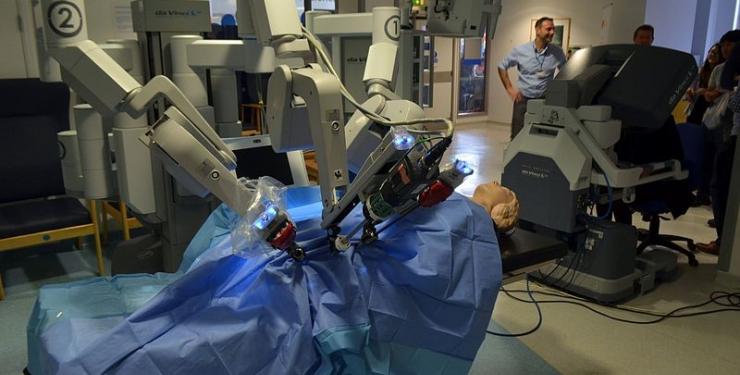The (Robot) Doctor Will See You Now!

Robots have been used in medicine since 2000 when the FDA first approved the da Vinci Surgical System. Sixteen years and 20,000 surgeries later, the concept of a robot performing surgery is not nearly as far-fetched as it seemed at the beginning of the century. Now the da Vinci system, and many others like it, perform surgeries every single day – and yet we are still only at the very beginning of the age of healthcare robotics. Recent breakthroughs in the field have made robots less expensive and more sophisticated in their capabilities, resulting in better levels of automation and increased abilities to work collaboratively with humans.
Over the next half decade, healthcare robotics is expected to experience enormous growth, with hundreds of new applications being found for robots in healthcare. In recent years, new robots have been developed to assist in physical therapy, provide care to remote patients (in an emerging field known as “telemedicine”), and distribute supplies within medical facilities.
Assistive Robotics
Some robots are used as assistive devices that help patients with everyday activities.
- The Bestic Arm aids patients with the eating process. Its appearance is basically that of a robotic arm holding a spoon. It sits on a table next to the patient, and can be easily calibrated to the needs of each individual user, who directs it using a personalized set of controls (joystick, buttons, foot controls).
Other robots assist with physical therapy. Toyota manufactures several Healthcare Assistants, which are robots that are designed to help patients who have been paralyzed regain their ability to walk or balance themselves in various specific ways:
- The two-wheeled Balance Training Assist behaves as a video game in which the patient stands on the robot and must shift their weight to maneuver within one of three different sports games.
- The Walk Training Assist is mounted onto the patient's paralyzed leg. It is equipped with sensors that detect the movement of the hips and moves the patient's knee and leg in a walking motion.
- The Independent Walk Assist helps retrain the patient to walk by supporting their weight while it helps the leg to move. Over time, the robot supports less and less of the patient's weight as the their walking becomes stronger.
Robot Porters
- The Aethon TUG delivers supplies like medication, food, and linens to different parts of the hospital. It can navigate crowded and unpredictable hospital halls, elevators, and departments, making scheduled or on-demand deliveries, operating at a fraction of the cost of one full-time employee while offering the productivity of three. In addition to this, it can be hooked up to various types of hospital carts to offer more versatility in fulfilling transportation needs.
- Another delivery system is the RoboCourier, which autonomously distributes lab samples, medications, and medical supplies wherever they are needed in the hospital. An operator gives the robot a destination for its cargo, and the robot independently finds the best way to get it there. It navigates using an internal mapping system, uses laser “eyes” to detect and avoid obstacles, and wirelessly signals doors to open for it as it passes. It announces its presence to human staff using voice-activated warnings.
Telemedical Robots
Medical robots are also making waves outside the hospital in the field of telemedicine.
- The Vasteras Giraff lets the elderly keep in touch with their physicians via a mobile two-way videoconferencing system. A camera and monitor mounted on wheels are controlled remotely by a caregiver.
- Anybots’ robots go even further, not just focusing on the ability of doctors to remotely communicate with patients, but also to move about and interact with the patient's environment. The doctor, rather than a caregiver, controls the movement of the robot and can use sensors to record data.
Microbots
Another new and exciting frontier is the emerging class of “microbots,” tiny robots that perform delicate and precise operations from within the patient's body. Some examples include:
- Steerable Surgeons, which are assembled from nickel and are steered magnetically to assist with retinal surgeries, drug therapies, and the treatment of ocular disease.
- Robot Pills, tiny capsules about 2 centimeters in length carrying cameras, wireless chips, magnets, and small mechanical legs, which are used in disease screenings.
- Plaque Busters, 10-millimeter-long magnetic capsules containing a small drill head that are used by surgeons to remove plaque from arteries.
There is a lot to be excited about in the field of healthcare robotics over the next few years. As more and more breakthroughs are made, hospitals will continue to automate and enhance existing jobs using robots. That's not to say that all hospital workers are going to be out of a job any time soon—we just might see a few more robotics technicians among them.
